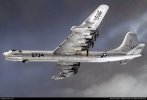As today, only the Russian Ilyushin Il-96 is built as a four engine jet airliner, but with 30 built since 1992, and 15 in use, it hardly competes with the B747. Apparently, after the failure of the Airbus A380, the four-engine era in passenger transport seems to be over.
The commercial aviation industry has been moving away from four engine planes for quite a while now. The 747 is being phased out of operation during the next decade or so - in fact most airlines that did operate the type have retired theirs years ago, as their older engines are horrendously inefficient in terms of fuel consumption compared to the big turbofans on more modern airlines like the 777 and various Airbus models.
Even with later 747 variants being fitted with more modern engines, the nature of commercial aviation, especially in the realm of passenger transport, has changed dramatically over the last couple of decades, all of which has contributed to the decline of these giants of the sky. With more modern aircraft being built more out of lightweight composite materials, the need for four engines has diminished, with most types today using two much more efficient engines proving to be not only more efficient in terms of fuel economy, but also simplifying maintenance and generally loweing the overall complexity of manufacture.
I think the biggest factor though is fuel economy. Most airlines today, especially the smaller ones, are operating on pretty thin margins, and to remain profitable they need to get the maximum number of seats filled (which generally requires lower ticket prices, thus cutting into their operating profits, so if you can save on the huge fuel costs (in 2022 the fuel cost amounts to around 24% of total expenditure by airlines on average - for smaller airlines that are merely leasing aircraft rather than buying them outright, this can easily rise to almost 50%), then that's the only viable way to remain in the black.
I think that the 747 will continue to be operated for a while by some of the big cargo operators, if only because it still takes some beating as a heavy freighter (Mainly due to its large capacity and ability to be front-loaded, thus able to take long cargo items which could not be accommodated by side-loading types - Let's not forget that the type was originally designed to be a freighter, with Boeing only switching production to passenger versions after losing the military C-X heavy lift contract to the Lockheed C-5 Galaxy), and will probably continue to be used to specialist roles for some time. Having said that, the very last 747 having been completed yesterday, and NASA retiring their SOFIA aerial telescope (based around a heavily modified 747SP) on 29th September 2022, even the niche operations are winding down these days, so it's very much the end of an era.
As many of you in here will be aware, my father was a commercial pilot for many years throughout the 60s and into the late 80s, and was lucky enough to get to fly as First Officer on the 747 for British Airways towards the end of his active flying career, after which he began training new pilots in ground-based simulators, only occasionally getting the chance to actually fly for real.
He often commented that the 747 was very sturdy but still surprisingly nimble for its huge size and weight, making it popular with pilots all over the world. For something that looks like it should never be able to get off the ground, with its four engines looking much too small to power such a huge plane, the power-to-weight ratio was incredible, and, it's become such a classic icon of 20th century design, that it is sure to live on in the imaginations of anyone with even the slightest interest or assocciation with the world of aviation.






